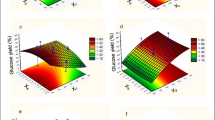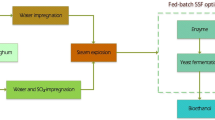Abstract
Sweet sorghum (Sorghum bicolor (L.) Moench) bagasse is a lignocellulosic material consisting mainly of hemicellulose and cellulose, a potential source of fermentable sugars. The present study aimed to optimize the hydrolysis of sweet sorghum bagasse to obtain the highest concentrations of xylose and glucose with the minimum amount of inhibitor compounds. Seven varieties of sweet sorghum bagasse were used for the hydrolysis experiment, carried out in three stages with a 23 Box–Behnken factorial design; the critical factors selected for both stages were H2SO4 and H2O2 concentrations, time and liquid–solid ratio (LSR). The alkaline hydrolysis was carried out with a subsequent enzymatic hydrolysis using 0.4 mL cellulose and 0.5 mL beta-glucosidase. The optimum conditions for acid hydrolysis were H2SO4 (1.375 % w/v), time (36 min) and LSR (4.9:1 v/w of bagasse) resulting in values of 11.55 g/L glucose and 41.27 g/L xylose, respectively; for alkaline hydrolysis H2O2 (4.5 % w/v), time (45 h) and LSR (16:1 v/w of bagasse) were the optimum values. Under these conditions, 65.96 g/L glucose concentration was obtained. Validation of the model indicated no difference between predicted and observed values in the optimization of the hydrolysis process.






Similar content being viewed by others
References
Aita, G.A. and M. Kim. 2010. Pretreatment technologies for the conversion of lignocellulosic materials to bioethanol sustainability of the sugar and sugar ethanol industries. ACS Symposium Series, 117–145. Washington, DC: American Chemical Society.
Almodares, A., and M. Hadi. 2009. Production of bioethanol from sweet sorghum: A review. African Journal of Agricultural Research 4(9): 772–780.
Alvira, P., E. Tomas-Pejo, M. Ballesteros, and M.J. Negro. 2010. Pretreatment technologies for an efficient bioethanol production process based on enzymatic hydrolysis: A review. Bioresource Technology 101: 4851–4861.
Barreiro, M. 1997. El sorgo mexicano: entre la autosuficiencia y la dependencia externa. Apoyos y Servicios a la Comercialización Agropecuaria (ASERCA). Revista Claridades Agropecuarias 46: 3–4.
Castañón, J.F., J.A. Portilla, B.R. Aguilar, and M.G. Aguilar. 2015. Effects of oxygen and nutrients on xylitol and ethanol production in sugar cane bagasse hydrolyzates. Food Sciences Biotechnology 24(4): 1381–1839.
Chen, C. 2011. Alternative pretreatment of sorghum bagasse for bio-ethanol production. Thesis Master of Science. Faculty of the Louisiana State University and Agricultural and Mechanical College: 3.
Chen, Y., R. Sharma-Shivappa, D. Keshwani, and C. Chen. 2007. Potential of agricultural residues and hay for bioethanol production. Applied Biochemistry and Biotechnology 142: 276–290.
Domínguez, C.X. 2013. Optimización del pretratamiento (ácido/alcalino) y la determinación de la influencia del tween 80 en la hidrolisis enzimática del olote. Tesis de Maestría. Instituto Tecnológico de Orizaba.
Domínguez, M., A. Álvarez, T. Castrejón, M. Granados, F. Hernández, V. Alcalá, and C. Tapia. 2011. Estudio de la cinética de la hidrólisis ácida del bagazo de caña de azúcar sin pretratamiento para la obtención de azúcares reductores. Revista Iberoamericana de Polímeros 12(3): 153–159.
Fazzio, A., D. Cazzolino, W. Ibáñez and E. Fernández. 2007. Sorgo: Destino forrajero. Serie Técnica 127. Unidad de Agronegocios y Difusión del Instituto Nacional de Investigación Agropecuaria, Uruguay.
Galbe, M., and G. Zacchi. 2007. Pretreatment of lignocellulosic materials for efficient bioethanol production. Advances in Biochemical Engineering/Biotechnology 108: 41–65.
Hahn-Hägerdal, B., M. Galbe, M.F. Gorwa-Grauslund, G. Liden, and G. Zacchi. 2006. Bio-ethanol—The fuel of tomorrow from the residues of today. Trends in Biotechnology 24: 549–556.
Infoagro. 2012. http://www.infoagro.com/herbaceos/forrajes/sorgo.htm. 6 de Noviembre de 2012.
Kaur, P., S.K. Uppal, C. Dhir, P. Sharma, and R. Kaur. 2015. Comparative study of chemical pretreatments and acid saccharification of bagasse of sugar crops for ethanol production. Sugar Tech 17(4): 412–417.
Keshwani, D.R., and J.J. Cheng. 2009. Microwave-based alkali pretreatment of switchgrass and coastal bermudagrass for bioethanol production. Biotechnology Progress 26: 644–652.
Khuri, A.I., and J.A. Cornell. 1987. Response surfaces: Design and analysis. New York: Marcel Dekker.
Kumar, P., D.M. Barrett, M.J. Delwiche, and P. Stroeve. 2009. Methods for pretreatment of lignocellulosic biomass for efficient hydrolysis and biofuel production. Industrial and Engineering Chemistry Research 48: 3713–3729.
Mamma, D., P. Christokopoulous, D. Koullas, D. Kekos, B. Macris, and E. Koukios. 1995. An alternative approach to bioconversion of sweet sorghum carbohydrates to ethanol. Biomass and Bioenergy 8(2): 99–103.
Marx, S., B. Ndaba, I. Chiyanzu, and C. Schabort. 2013. Fuel ethanol production from sweet sorghum bagasse using microwave irradiation. Biomass and Bioenergy 65(2014): 145–150.
Mesa, L., E. González, I. Romero, E. Ruiz, C. Cara, and E. Castro. 2001. Comparison of process configurations for ethanol production from two-step pretreated sugarcane bagasse. Chemical Engineering Journal 175: 185–191.
Mikán, V., and D. Castellanos. 2004. Screening para el aislamiento y caracterización de microorganismos y enzimas potencialmente útiles para la degradación de celulosas y hemicelulosas. Revista Colombiana de Biotecnología VI 1: 58–71.
Montgomery, D.C. 2005. Design and analysis of experiments, 6th ed. New York: Wiley.
Nápoles, A., Y. Ortiz, M. Viñals, E. Manganelly, and E. Acosta. 2006. Purificación de hidrolizado de bagazo de caña de azúcar con carbón activado y resinas de intercambio iónico. Ciencia y Tecnología Alimentaria 5(2): 124–128.
Nochebuena, L.E. 2013. Estudio del efecto del tratamiento oxidativo y del Tween 80 sobre la hidrólisis enzimática del bagazo de caña de azúcar. Tesis de Maestría. Instituto Tecnológico de Orizaba.
Pernalet, Z., F. Piña, M. Suárez, A. Ferrer, and C. Aiello. 2008. Fraccionamiento del bagazo de caña de azúcar mediante tratamiento amoniacal: efecto de la humedad del bagazo y la carga de amoníaco. Bioagro 20(1): 3–10.
Soto, L.C. 2011. Diseño de una planta productora de bioetanol, a partir de sorgo dulce (Sorghum vulgare) para la implementación en el Estado de Guanajuato. Tesis Profesional. Instituto Tecnológico de Veracruz.
Van, S.P.J., J.B. Robertson, and B.A. Lewis. 1991. Methods for dietary fiber, neutral detergent fiber, and nonstarch polysaccharides in relation to animal nutrition. Journal of Dairy Science 74: 3583–3597.
Varela, R. 2007. Estudio del Sorgo Dulce como alternativa de cultivo energético en la producción de energías alternas renovables. Colombia: CERTA Research & Consulting, Inc.
Vázquez, H., and O. Dacosta. 2007. Fermentación alcohólica: Una opción para la producción de energía renovable a partir de desechos agrícolas. Ingeniería, Investigación y Tecnología VIII(4): 249–259.
Vogel, K.P., J.F. Pedersen, S.D. Masterson, and J.J. Toy. 1999. Evaluation of a filter bag system for NDF, ADF, and IVDMD forage analysis. Crop Science 39: 276–279.
Worly, J., D. Vaugha, and J. Cundiff. 1992. Energy analysis of ethanol production from sweet sorghum. Bioresource Technology 40: 263–273.
Ying, G., H. Shan-ying, L. You-run, C. Ding-ying, Z. Bing, and K. Smith. 2010. Optimization and analysis of a bioethanol agro-industrial system from sweet sorghum. Renewable Energy 35: 2902.
Acknowledgments
The authors acknowledge the economic support from the National Council of Science and Technology, Mexico (CONACyT-SAGARPA, Project 173411) and the critical reading of Patricia Margaret Hayward-Jones, M.Sc. and Dulce María Barradas-Dermitz, M.Sc.
Author information
Authors and Affiliations
Corresponding author
Ethics declarations
Conflict of interest
The authors declare that they have no conflict of interest.
Rights and permissions
About this article
Cite this article
Partida-Sedas, G., Montes-García, N., Carvajal-Zarrabal, O. et al. Optimization of Hydrolysis Process to Obtain Fermentable Sugars from Sweet Sorghum Bagasse Using a Box–Behnken Design. Sugar Tech 19, 317–325 (2017). https://doi.org/10.1007/s12355-016-0461-y
Received:
Accepted:
Published:
Issue Date:
DOI: https://doi.org/10.1007/s12355-016-0461-y




